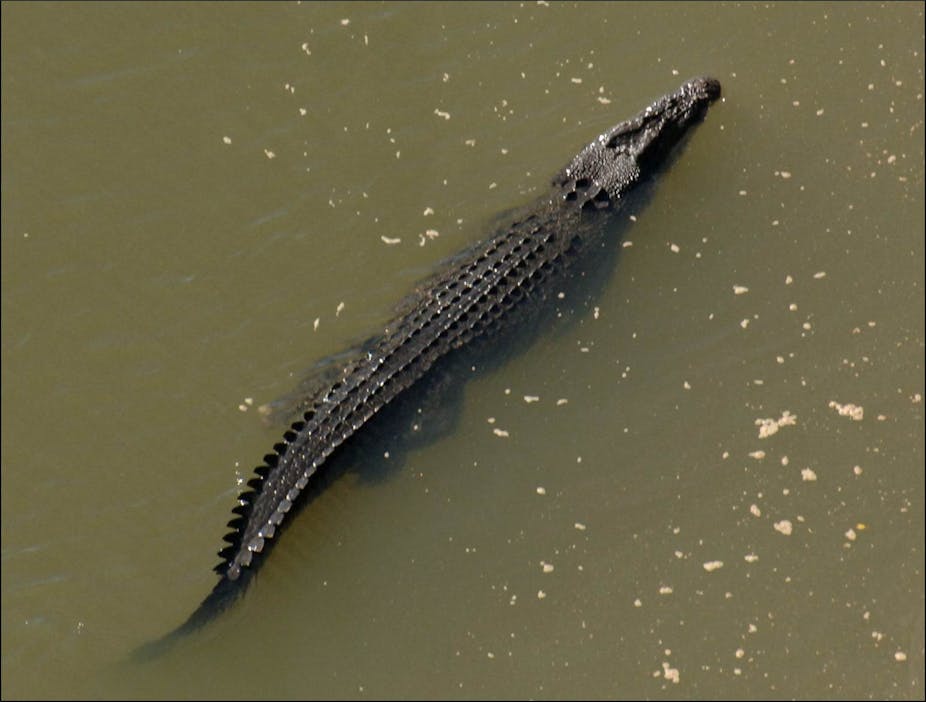The estuarine crocodile is the top predator in waterways across Northern Australia. Large crocodiles pose a risk to humans, so local governments take measures to control crocodile abundance and distribution.
Keeping crocs away
Crocodiles are regularly trapped and removed from around urban centres and areas that lots of people visit. While this strategy appears to work reasonably well in reducing human-crocodile interactions, it may in fact give the public a false sense of security. Few will certify that it is definitely safe to get back into the water!
Both the Northern Territory and Queensland have “zero-tolerance zones”. All crocodiles over a certain size are removed from these. In the Northern Territory this comprises a large area around Darwin Harbour. In Queensland, zero-tolerance zones occur across the boundaries of various local councils, and these zones are generally much smaller but more numerous.

The “problem crocodiles” that turn up in these areas are predominantly males between 2m and 4m long. The number of crocodiles trapped and removed each year is rising. The capture, removal and transport of crocodiles requires significant man-power, so the costs of this management strategy are rising too.
The role of large males
David Lindner, a local crocodile enthusiast, suggested to us that a large male crocodile (which he called the “boss croc”) dominated a local billabong. The billabong had a lot of permanent females, and when the boss croc was around the other male crocodiles seemed to disappear.
This behaviour implies that estuarine crocodiles exist within a socially structured population. That made us reflect on how removing very large male crocodiles would affect the dynamics of the local population.
In researching our recent scientific paper in Plos ONE we attached high precision satellite transmitters to eight male and four female estuarine crocodiles and monitored their movements continuously for six months.
We wanted to understand the social interaction between boss crocs, females and subordinate males, and assess how far and fast subordinate male crocodiles travel.
We found that the boss crocs inhabited defined territories of between 7 and 12 square kilometres on the river. The boss croc would patrol back and forth within the confines of this territory at least once and sometimes twice a day.

A number of breeding females would live inside the boss croc’s home range. They moved only a few hundred metres each day and always returned to the same location. Our satellite data really supported the observations of David Lindner. That is, boss crocs dominate good crocodile habitat containing a number of females. Although unconfirmed it is likely that resource rich areas have the largest male crocodiles and the greatest numbers of females.
The satellite tagged subordinate male crocodiles, which at 3.5m were still large crocodiles, bore many scars from aggressive encounters with other crocodiles. These individuals moved quickly through the territories of the boss crocs and travelled great distances (up to 1000km) during the six-month study.
This evidence suggests that boss crocs aggressively excluded subordinate males from within their territories. The nomadic behaviour of the subordinate was in response to their exclusion from high quality habitat and was an attempt to locate unguarded females.
What happens when you take out a boss?
Our study illustrates that estuarine crocodiles are incredibly mobile animals, and may routinely travel up to 40km a day. Furthermore, it suggests that removing a dominant male crocodile from an area is likely to disrupt the social structure of the local crocodile population.
Removing these dominant individuals is likely to create a vacuum which may serve to increase movement and immigration of other males from neighbouring areas.
This study demonstrates that estuarine crocodiles exist within a social structure that is far more complex than we previously considered.Furthermore, social dynamics are likely to be controlling crocodile abundance and distribution.
Trophy hunting estuarine crocodiles in the Northern Territory has been proposed as one way to bring needed money into remote communities. While we do not think sport hunting will make any significant impact on crocodile numbers, the hunters are likely to focus their killing on the largest male crocodiles. This is of concern, because we don’t know how removing these boss crocs is going to affect the dynamics of the population.
In African lion populations, it has been shown that when sport hunters remove the large dominant males, it causes much greater rates of movement in the subordinate males.
We strongly recommend a thorough evaluation of the impact crocodile removal has on the social dynamics of the population. Evaluation is the only way to make sure management strategies achieve what they set out to do: keep people safe from crocodiles.

